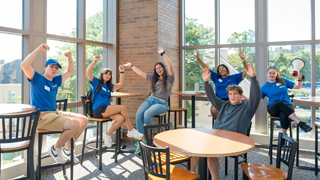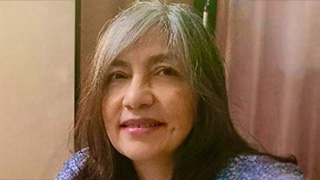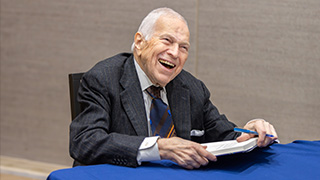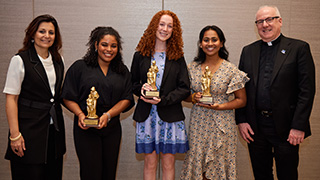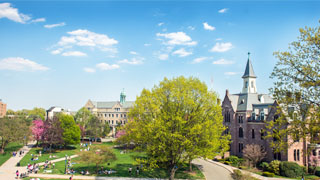CommArts Students Present Virtual Projects on Communication in Abrahamic Scripture for Petersheim Academic Expo 2020
Tuesday, May 12, 2020
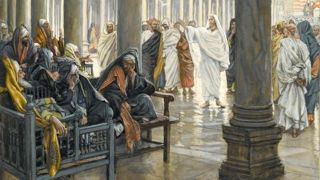
In her virtual project, communication major Rhania Kamel illustrated her point about Jesus’ relationship with the social hierarchy via this 19th century painting. [James Tissot (1836-1902). Woe unto You, Scribes and Pharisees (Malheur à vous, scribes et pharisiens) (1886-1894). Opaque watercolor over graphite on gray wove paper, 17 x 26.4 cm, Brooklyn Museum, NY. Wikimedia Commons.]
The third week of April is annually allocated for the University's Petersheim Academic Exposition to celebrate notable student work through conference-style poster presentations. This year called for a change in the tradition, however, as the exposition was transitioned online in accord with the University's coronavirus pandemic guidelines. Works by undergraduate and graduate students, faculty and staff centered around the theme, "Share, Honor, Unite" and were presented through Microsoft Teams.
Six student projects from the special topics course, Communication in Abrahamic Religions, were hosted by the Institute for Communication and Religion (ICR). The course, designed and taught by ICR Director Jon Radwan, Ph.D., is unique to the College of Communication and the Arts. It addresses communication and social power within the Hebrew Bible, Greek Bible and Qur'an to advance the Institute's mission and encourage exploration of communication topics essential to religion and society. The entries selected for the exposition discussed a range of topics including Jesus' communication model, interpersonal power dynamics, and social class structures within sacred texts.
Student presenter and communication major Ellen Paul said, "Often as a society we just hear about or focus on the differences and negative relationships between different religions, so I really enjoyed being able to create and be a part of a dialogue of different faiths." Paul shared how the course discussions lead her to her project's topic. "We read from Amos, a Hebrew prophet who was a member of the lower class. I found the communication structures in this situation very interesting as God spoke to Amos who relayed God's message to those in social classes above him. I thought this was intriguing, and wanted to explore spiritual and worldly power in Abrahamic scriptures," said Paul.
Students also spoke on the surprising effectiveness of a remote-learning situation as the pandemic shifted the University's regular operations and Dr. Radwan's teaching to an online format.
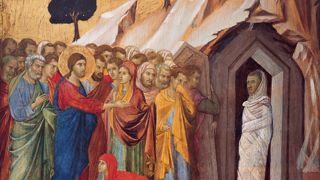
Communication major Devin Luehs used this famous 14th century painting in her presentation to help explain how Jesus communicated His humanity to the people of Bethany. [Duccio di Buoninsegna (c 1255–1318), The Raising of Lazarus (1310–11). Tempera and gold on panel, 43.5 x 46.4 cm, Kimbell Art Museum, Fort Worth, TX. Wikimedia Commons.]
"Surprisingly, my ability to research was not affected by the pandemic," said presenter and communication major Devin Luehs. "I enjoyed presenting through Microsoft Teams and believe that the exposition was a success. I have adjusted to online school work nicely, and was able to better focus on my research because of my free time."
Audience members were able to ask questions via the Microsoft Teams chat feed. Afterward, several agreed that the event was both educational and successful. ICR Steering Committee member and communication professor Catherine Zizik, M.F.A. expressed gratitude for a "very robust" session and told student presenters "we are proud of your level of analysis and ability to engage extemporaneously in the question and answer portion of the program." Lorraine Joyce, senior account manager in the Department of Public Relations and Marketing, was quick to praise student researchers and their communication skills. "I tuned in for the presentations and it was very well done!" she said. "The students did great and knew their material."
Despite challenges that virtual conferences may present, the digital format also introduced unique opportunities for the academic event. For the first time, student presentations were witnessed by both members of the University community and international online audiences. Additionally, thanks to the capabilities of Microsoft Teams, the presentations were recorded and submitted to the National Communication Association (NCA) for the online publication "Special Series: Poster Sessions." NCA is the largest professional association of communication academics in the United States, working to "advance communication as the discipline that studies all forms, modes, media, and consequences of communication through humanistic, social scientific, and aesthetic inquiry." As a response to the coronavirus pandemic, this growing NCA Poster Session repository showcases brief thesis and dissertation defense presentations, as well as poster presentations like those of the Petersheim Academic Exposition, that were originally planned for physical conferences.
In addition to hosting on the NCA website, each student's recorded presentation is also available for public viewing on the NCA's official YouTube channel. The Seton Hall topics and presenters featured are:
- "St. Paul's God Problem" – Presented by Mark Graziano
- "Jesus' Communication in John 11" – Presented by Devin Luehs
- "Communication and Power: Jesus and The Pharisees" – Presented by Rhania Kamel
- "The Power from Within: Communication and Power in the Bible" – Presented by Alli Olla
- "Empowering the Lower Class in Abrahamic Scriptures" – Presented by Ellen Paul
- "Hemorrhaging Woman: A Transfer of Divine Power" – Presented by Chris Rice
Following the completion of their projects and presentations, students shared their takeaways from the unique course and its most interesting aspects. "It is certainly interesting that a common thread is found to be woven through three popular religions: Islam, Christianity, and Judaism," Rice commented. "It is inspirational that a Catholic university like ours produces diversified courses such as this that promote the understanding of others and their beliefs."
Luehs shared similar sentiments. "I would recommend this course to others because being able to gain knowledge on different religions is significant, as our world is a melting pot." Luehs continued, "By understanding your peers or a stranger's religion you can form a dialogue. Additionally, this can connect you with people by better understanding someone else's religion and showing an interest in their practice."
The students ultimately recommended the course and encouraged fellow students to craft projects for the Petersheim Academic Exposition. "Although my participation started off as a class requirement, I found myself really excited about my research and to have the opportunity to discuss it with others beyond the scope of my class," said Kamel, who shared advice for those hoping to participate in future Petersheim events. "When you've got a personal connection to what you're doing, it makes the work that much easier and enjoyable to pursue," she said. "Additionally, the questions from the audience and feedback from my peers functioned as a sounding board for me as I finalized my research."
On the success of the Institute's event within Petersheim and now NCA, ICR Director Radwan expressed pride in Seton Hall's student researchers. "Despite the pandemic our students are working hard to learn about important topics like Communication and Religion," he said. "Sharing their research progress reports digitally celebrates their work, and now their work reaches a much larger audience than a physical event ever could. The coronavirus can't stop Petersheim, and in rising to the challenge of online production and distribution we've made a great event even better. Hazard zet forward!"
About the Institute for Communication and Religion
Launched in Fall 2017, the Institute for Communication and Religion within the College of Communication and the Arts provides a nexus for ongoing scholarly exploration of communication topics critically
important to religion and society. Guided by the spirit of ecumenical and interreligious
cooperation, the Institute seeks to engage in public dialogue and debate, promote
academic inquiry and support the religious dimension of creativity — all while upholding
the values of servant leadership, curricular innovation and intellectual excellence.
For more information on Institute for Communication and Religion »
Categories: Arts and Culture

